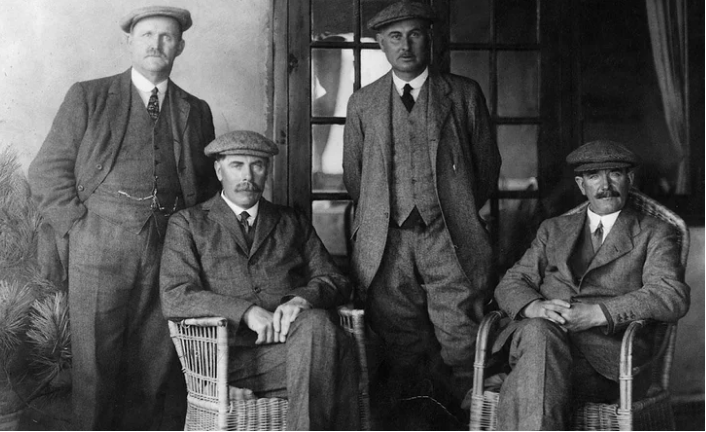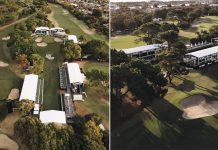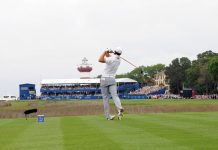
The last time the U.S. Open was contested at The Country Club, Curtis Strange and Nick Faldo each finished at 6-under par, forcing a Monday playoff, where the American won by four strokes.
In total there were 11 players that week in Boston who shot under par, more than the previous five editions, combined – which was nine (9).
It wasn’t that fair, however, the previous time the U.S. Open had been contested at The Country Club. In 1963, high winds in Boston made scoring conditions extremely difficult, particularly during Saturday’s final two rounds (the final two rounds were played on Saturday until 1964), when gusts approached 50 mph.
Julius Boros’ winning score of 293 remains the highest in post-World War II U.S. Open history, while the 77.4 final-round scoring average set a record for the post-war era, later broken in 1972 at Pebble Beach. For the first time in U.S. Open history, no amateur made the cut.
As brutal as it was that week in Boston, it was far from the only time that a remorseless U.S. Open track enveloped an entire field of elite golfers.
Here’s a look at some of the more memorable ones, including the 1963 beatdown:
1. Myopia Hunt Club (1898, 1901 and 1908)

I’m grouping these three U.S. Opens together because golf was such a different game back then. Pars had not even existed yet. While it is impossible to compare those tournaments to more recent ones, there were some interesting stories that should be recognized.
The Myopia Hunt Club was a originally nine-hole course, and to get to 72 holes, the golfers had to play each nine eight times. In the 1898 edition, the only U.S. Open at Myopia before the expansion to 18 holes, winning golfer Fred Herd shot three rounds in the 80s and still won. The 1901 version had to be spread out over five days to accommodate member play.
The players in the 1908 U.S. Open had to deal with high winds in addition to the normal course difficulties, which showed as nobody carded a round of less than 77 the entire tournament. Professional golf was in its nascency, and man had yet to tame it.
Winning Scores: 328 Fred Herd, 331 Willie Anderson, 322 Fred McLeod, respectively
2. Merion Golf Club (1934)

The 1934 U.S. Open was held at Merion Golf Club near Philadelphia. Olin Dutra won his only U.S. Open, a stroke ahead of runner-up Gene Sarazen on the East Course. Dutra overcame an eight-stroke deficit after 36 holes to win his second major title.
Amid brutal windy conditions that reached “semi-gale velocity,” Dutra posted all four rounds over par but his 13-over par was good enough to win the $1,000 first prize.
Winning Score: Olin Dutra +13 (293)
3. Oakmont CC (1935)

Held at Oakmont Country Club, northeast of Pittsburgh. Sam Parks, Jr., a 25-year-old club pro at nearby South Hills Country Club with no prior tournament wins, prevailed by two strokes in amid severe weather and brutally difficult scoring conditions.
The weather was even worse during the final round, yet Parks shot a 76 for a two-stroke victory. Walter Hagen briefly led during the final round, but four consecutive bogeys knocked him back to third. It would be the last time that Hagen would contend in a major championship.
Scoring conditions were so difficult that Parks’ 299 was the only score under 300.
“I’ve said from coast to coast that Oakmont is the toughest course in the world. It showed in this tournament. It made a wreck out of most of us,” wrote Gene Sarazen in a wire article.
“The test was made even more severe by the placing of the pins… I am glad the ordeal is all over. After Oakmont I feel the need of a rest. So on my farm in Connecticut I will take things easy.”
Winning Score: Sam Parks, Jr. +11 (299)
4. Oakland Hills CC (1951)

The 1951 U.S. Open was held at the South Course of Oakland Hills Country Club in Bloomfield Hills, northwest of Detroit. Ben Hogan won his second consecutive U.S. Open title, two strokes ahead of runner-up Clayton Heafner. Hogan missed the 1949 U.S. Open due to an automobile accident; this was his third title in his last three attempts.
The South Course, dubbed “The Monster,” played exceptionally tough for the first three rounds with Jimmy Demaret’s third-round even-par 70 the only score not over par.
Hogan played one of the finest rounds in U.S. Open history in round four though. Even-par on the front nine, Hogan birdied Nos. 10 and 13. After a bogey at 14, he responded with another birdie at 15, and then closed with birdie to post 67 (−3), the lowest round of the week, and one of two sub-par rounds for the championship.
At the trophy presentation, Hogan uttered the famous quote: “I’m glad I brought this course—this monster—to its knees.”
This was also the first U.S. Open that was notably toughened up by the USGA with narrow fairways and deep rough, attributing to “The Monster” nickname.
Winning Score: Ben Hogan +7 (287)
5. Olympic Club (1955)

The 1955 U.S. Open was the 55th U.S. Open, contested at the Lake Course of the Olympic Club in San Francisco (CA). In one of the greatest upsets in golf history, Jack Fleck, a municipal course pro from Iowa, prevailed in an 18-hole playoff to win his only major title and denied Ben Hogan a record fifth U.S. Open.
Fleck birdied the final hole to produce the only sub 70 round on Sunday and force a playoff which he won. Fleck and Hogan both finished +7 with the closest chasers being Tommy Bolt and Sam Snead who were +12. Julius Boros and Bob Rosburg shared fifth on +15.
Ironically, Fleck won playing clubs manufactured by Hogan’s golf equipment company.
Winning Score: Jack Fleck +7 (287)
6. The Country Club (1963)

Before he became the oldest second oldest to ever win a major, Julius Boros was the survivor at the end of 1963’s U.S. Open carnage. One stat from this tournament that shows how just how tough it was: Jack Nicklaus missed the cut at +11, and this event was in the early part of the Golden Age of the Golden Bear.
The winds at the Boston area course wrecked havoc during the entire tournament, with gusts reaching upwards of 50mph! A combination of the wind, deep rough, and small greens made 1963 one that most of its participants would like to forget.
Winning Score: Julius Boros +9 (293)
7. Winged Foot (1974)

The 1974 U.S. Open was such a disaster for the players that it became known as “The Massacre at Winged Foot.” A combination of treacherous conditions and alleged overcompensation of the course set-up in the aftermath of Johnny Miller’s famous round of 63 the year prior, produced a tournament unlike like one that had never been seen before.
The rough was nearly unplayable; well-over six inches in many spots. Miller exclaimed that it was impossible to hit out of it with anything other than a wedge. Any drive not hit into the fairway was almost guaranteed to lead to lost strokes.
Winning Score: Hale Irwin +7 (287)
8. Pebble Beach (2000)

I cannot hold it against Pebble Beach for getting mauled by Tiger in 2000. He was Ali/Ruth/Gretzky all rolled into one at that point in his career. Ripping Pebble Beach for Tiger’s score would be like criticizing Barry Sanders for never winning a ring with the Lions. The Detroit Lions franchise is an unstoppable vortex of losing. Just like Pebble, Barry never had a chance.
Nobody else was able to figure out how to keep their balls on line on the frustratingly brutal, much criticized poa annua greens, and as a result, the best non-Tiger score was the +3 posted by Ernie Els and Miguel Angel Jimenez.
Ryan Moore once said that Pebble’s greens under the old setup required shots that he “can’t physically do”, which did not seem to bring about much disagreement.
Winning Score: Tiger Woods -12 (272)
Best score among players not named Tiger: +3 (287)
9. Winged Foot (2006)

The Massacre was not the only time that Winged Foot played unbelievably difficult. 2006 was one of those special tournaments that is remembered less for what the winner was able to do, and much more for how others lost it. This was the year that Phil Mickelson stood on the 18th tee box with a one-stroke lead, and double bogeyed.
Mickelson’s collapse occurred immediately after Colin Montgomerie had three-putted the same hole for a double bogey of his own, and Jim Furyk missed a short putt that would have forced a playoff.
The difficulties of Mickelson, Montgomerie, and Furyk on 18 can be largely imputed on major championship pressure, but their sky-high final scores, and the troubles of the rest of the field showcased just how tough Winged Foot played.
Winning Score: Geoff Ogilvy +5 (285)
10. Oakmont CC (2007)

Angel Cabrera won his first major championship, one stroke ahead of runners-up Jim Furyk and Tiger Woods, who were unable to birdie the 72nd hole to force a Monday playoff. Cabrera’s victory marked the first U.S. Open won by an Argentine or a South American. It was the first of his two major titles – he won the Masters in a playoff in 2009.
The field broke par for only eight rounds during the tournament, just two players per day on the difficult Oakmont layout, and Cabrera was the only player to break par twice.
Winning Score: Angel Cabrera +5 (285)
This story originally appeared in 2016. The lead-in was updated to relate to the current U.S. Open edition.






































